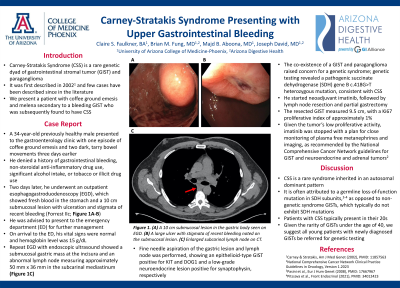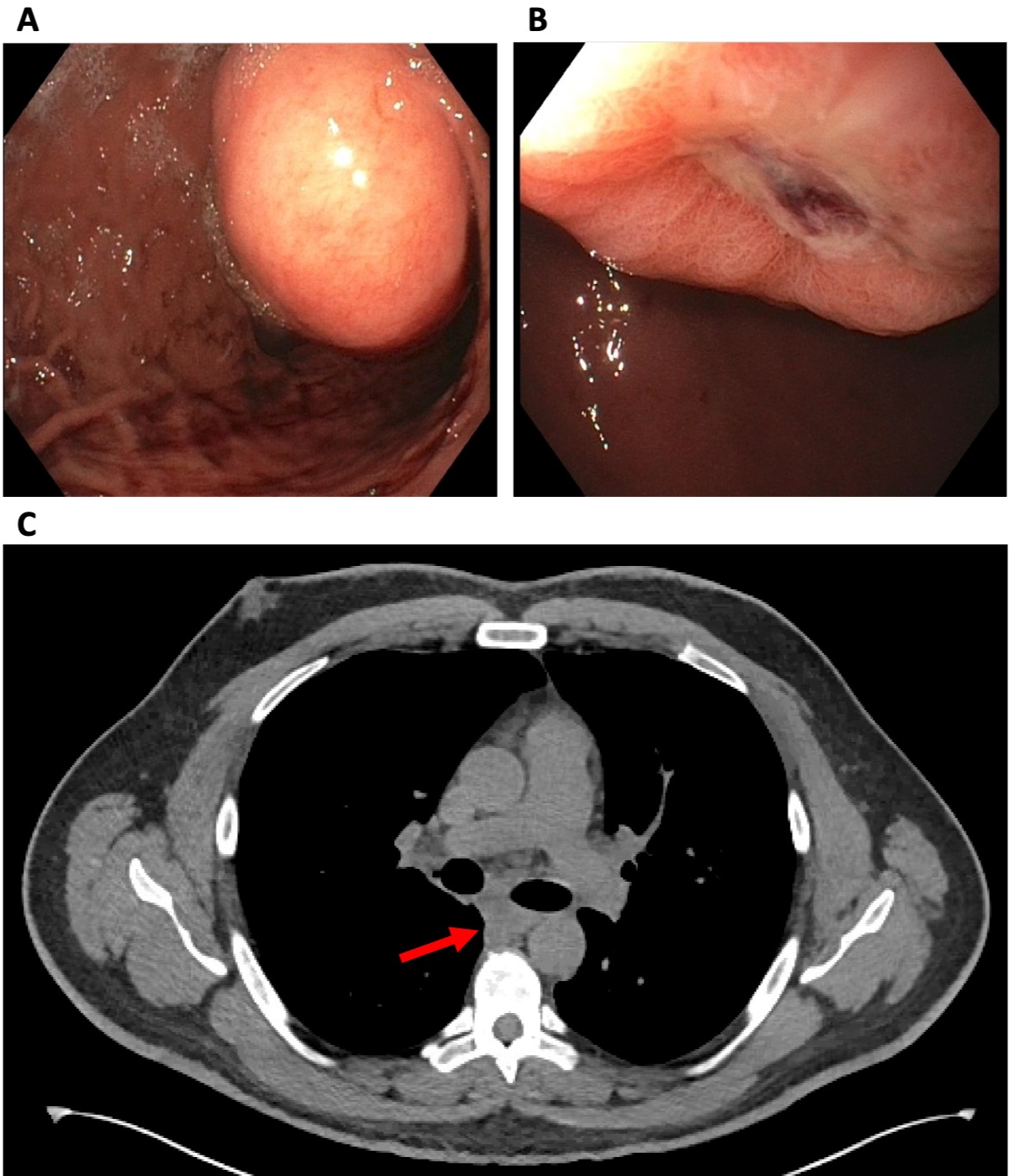Tuesday Poster Session
Category: Stomach
P4242 - Carney-Stratakis Syndrome Presenting With Upper Gastrointestinal Bleeding
Tuesday, October 24, 2023
10:30 AM - 4:00 PM PT
Location: Exhibit Hall

Has Audio

Claire Faulkner, BA
University of Arizona College of Medicine
Phoenix, AZ
Presenting Author(s)
Claire Faulkner, BA, Brian M.. Fung, MD, Majd B. Aboona, MD, Joseph David, MD
University of Arizona College of Medicine, Phoenix, AZ
Introduction: Carney-Stratakis syndrome (CSS) is a rare genetic dyad of gastrointestinal stromal tumor (GIST) and paraganglioma. First described in 2002, few cases have been reported in the literature. We present a patient with coffee ground emesis and melena secondary to a bleeding GIST who was subsequently found to have CSS.
Case Description/Methods: A 34-year-old previously healthy male presented to the gastroenterology clinic with one episode of coffee ground emesis and two dark, tarry bowel movements three days earlier. He denied a history of gastrointestinal bleeding, non-steroidal anti-inflammatory drug use, significant alcohol intake, tobacco or illicit drug use. Two days later, he underwent an outpatient esophagogastroduodenoscopy (EGD), which showed fresh blood in the stomach and a 10cm submucosal lesion with ulceration and stigmata of recent bleeding (Forrest IIc; Figure 1A-B). He was advised to present to the emergency department (ED) for further management.
On arrival to the ED, his vital signs were normal and hemoglobin level was 15 g/dL. Repeat EGD with EUS showed a submucosal gastric mass at the incisura and an abnormal lymph node measuring approximately 50mm x 36mm in the subcarinal mediastinum (Figure 1C). Fine needle aspiration of the gastric lesion and lymph node was performed, showing an epithelioid-type GIST positive for KIT and DOG1 and a low-grade neuroendocrine lesion positive for synaptophysin, respectively. The co-existence of a GIST and paraganglioma raised concern for a genetic syndrome; the patient underwent genetic testing, which revealed a pathogenic SDHB c.418G >T heterozygous mutation, consistent with CSS.
He started neoadjuvant imatinib, followed by lymph node resection and partial gastrectomy. The resected GIST measured 9.5 cm, with a Ki67 proliferative index of approximately 1%. Given the tumor’s low proliferative activity, imatinib was stopped with a plan for close monitoring of plasma free metanephrines and imaging, as recommended by the National Comprehensive Cancer Network guidelines for GIST and paraganglioma.
Discussion: CSS is a rare syndrome inherited in an autosomal dominant pattern. It is often attributed to a germline loss-of-function mutation in succinate dehydrogenase gene (SDH) subunits, as opposed to non-genetic syndrome GISTs, which typically do not exhibit SDH mutations. Patients with CSS typically present in their 20s. Given the rarity of GISTs under the age of 40, we suggest all young patients with newly diagnosed GISTs be referred for genetic testing.

Disclosures:
Claire Faulkner, BA, Brian M.. Fung, MD, Majd B. Aboona, MD, Joseph David, MD. P4242 - Carney-Stratakis Syndrome Presenting With Upper Gastrointestinal Bleeding, ACG 2023 Annual Scientific Meeting Abstracts. Vancouver, BC, Canada: American College of Gastroenterology.
University of Arizona College of Medicine, Phoenix, AZ
Introduction: Carney-Stratakis syndrome (CSS) is a rare genetic dyad of gastrointestinal stromal tumor (GIST) and paraganglioma. First described in 2002, few cases have been reported in the literature. We present a patient with coffee ground emesis and melena secondary to a bleeding GIST who was subsequently found to have CSS.
Case Description/Methods: A 34-year-old previously healthy male presented to the gastroenterology clinic with one episode of coffee ground emesis and two dark, tarry bowel movements three days earlier. He denied a history of gastrointestinal bleeding, non-steroidal anti-inflammatory drug use, significant alcohol intake, tobacco or illicit drug use. Two days later, he underwent an outpatient esophagogastroduodenoscopy (EGD), which showed fresh blood in the stomach and a 10cm submucosal lesion with ulceration and stigmata of recent bleeding (Forrest IIc; Figure 1A-B). He was advised to present to the emergency department (ED) for further management.
On arrival to the ED, his vital signs were normal and hemoglobin level was 15 g/dL. Repeat EGD with EUS showed a submucosal gastric mass at the incisura and an abnormal lymph node measuring approximately 50mm x 36mm in the subcarinal mediastinum (Figure 1C). Fine needle aspiration of the gastric lesion and lymph node was performed, showing an epithelioid-type GIST positive for KIT and DOG1 and a low-grade neuroendocrine lesion positive for synaptophysin, respectively. The co-existence of a GIST and paraganglioma raised concern for a genetic syndrome; the patient underwent genetic testing, which revealed a pathogenic SDHB c.418G >T heterozygous mutation, consistent with CSS.
He started neoadjuvant imatinib, followed by lymph node resection and partial gastrectomy. The resected GIST measured 9.5 cm, with a Ki67 proliferative index of approximately 1%. Given the tumor’s low proliferative activity, imatinib was stopped with a plan for close monitoring of plasma free metanephrines and imaging, as recommended by the National Comprehensive Cancer Network guidelines for GIST and paraganglioma.
Discussion: CSS is a rare syndrome inherited in an autosomal dominant pattern. It is often attributed to a germline loss-of-function mutation in succinate dehydrogenase gene (SDH) subunits, as opposed to non-genetic syndrome GISTs, which typically do not exhibit SDH mutations. Patients with CSS typically present in their 20s. Given the rarity of GISTs under the age of 40, we suggest all young patients with newly diagnosed GISTs be referred for genetic testing.

Figure: Figure 1. A) A 10 cm submucosal lesion in the gastric body seen on EGD. B) A large ulcer with stigmata of recent bleeding noted on the submucosal lesion. C) Enlarged subcarinal lymph node on CT.
Disclosures:
Claire Faulkner indicated no relevant financial relationships.
Brian Fung indicated no relevant financial relationships.
Majd Aboona indicated no relevant financial relationships.
Joseph David indicated no relevant financial relationships.
Claire Faulkner, BA, Brian M.. Fung, MD, Majd B. Aboona, MD, Joseph David, MD. P4242 - Carney-Stratakis Syndrome Presenting With Upper Gastrointestinal Bleeding, ACG 2023 Annual Scientific Meeting Abstracts. Vancouver, BC, Canada: American College of Gastroenterology.
